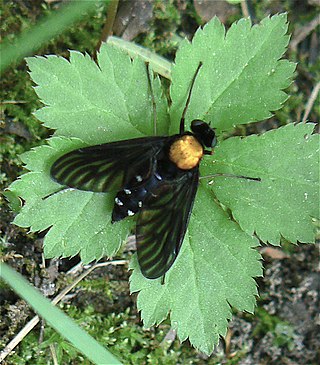
Chrysopilus is common, worldwide genus of predatory snipe flies. There are approximately 300 species in the genus, including fossil members that are sometimes found in amber.

Rhagio is a worldwide genus of predatory snipe flies. Several species in this genus are referred to as downlooker or down-looker flies because they sometimes perch on tree trunks in a head-down position. There are approximately 170 species. They can be distinguished from other rhagionids by the open anal cell on the wings and the lack of a kidney-shaped arista.
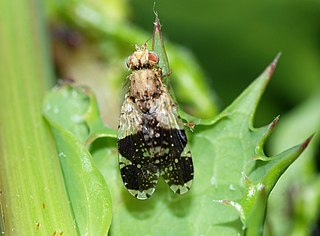
Tephritis is a genus of flies. It contains around 170 described species, making it the sixth largest genus in the family Tephritidae. Many more undescribed species are known from specimen collections. Tephritis occur throughout much of the world, but most are Palearctic. They can be found in a wide range of climate types, from hot semidesert to tundra. Most species inhabit the inflorescences of plants from several tribes in the family Asteraceae, and a few species cause galls to form.

Urophora is a genus of tephritid or fruit flies in the family Tephritidae.

Chalcosyrphus is a genus of hoverflies in the subfamily Eristalinae. Many species exhibit some degree of mimicry of various sawflies and other hymenopterans and are often brightly coloured or metallic in hue. The adults are similar in structure and behavior to the related genus Xylota but differ in larval morphology. They can be found throughout Europe, Asia, and North America and seem to prefer damper, boggy habitats. The larvae are saproxylic feeders in rotten wood in these habitats.

Chrysogaster solstitialis is a European species of hoverfly.
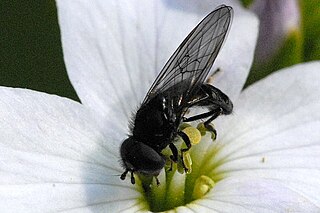
Triglyphus is a genus of hoverflies from the family Syrphidae in the order Diptera.

Triglyphus primus is a species of hoverfly, from the family Syrphidae, in the order Diptera. The larvae seem to be host-specific to an aphid species Cryptosiphum artemisiae which creates galls on Mugwort Artemisia vulgaris.

Empis is a genus of dance fly found in the fly family Empididae.
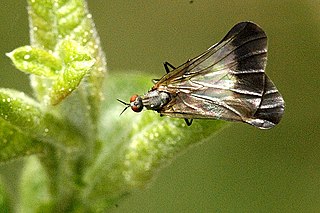
Rhamphomyia is a genus of dance flies, in the fly family Empididae.

Ocydromia is a genus of flies in the family Hybotidae.

Pipizini is a tribe of small to medium-sized generally black hoverflies, although some species also have orange spots on their abdomen. This nondescript colouring can lead to some species being confused with other dark hoverflies from other tribes. The lack of a facial knob is a good defining feature which separates them from most of these other hoverflies. As with other species in the subfamily Syrphinae the larvae feed on aphids though there seems to be a preference for wax-secreting aphids e.g. Pemphigidae.

Chloromyia formosa is a species of soldier flies belonging to the family Stratiomyidae. Another name for it is Broad centurion.
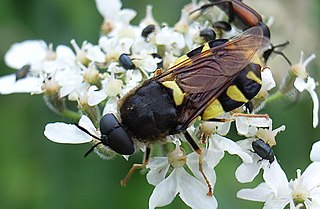
Stratiomys is a genus of flies in the family Stratiomyidae.

Oplodontha viridula, the common green colonel, is a European species of soldier fly.

Odontomyia ornata, also called the ornate brigadier, is a European species of soldier fly.

Oxycera is a genus of flies in the family Stratiomyidae.

Oxycera pardalina, the hill soldier, is a European species of soldier fly.

Chrysopilus erythrophthalmus is a Palearctic species of snipe fly in the family Rhagionidae.

Crossopalpus is a genus of flies in the family Hybotidae.



















